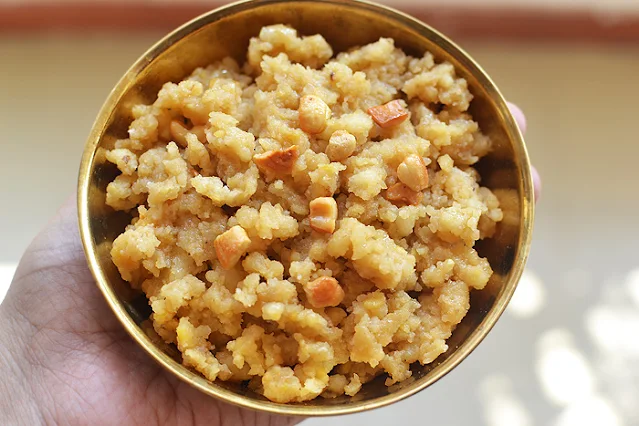Thiruvathirai Kali Recipe Guide: A Step-by-Step Experience-Based Approach
Thiruvathirai Kali is a traditional South Indian dish closely associated with the festival of Thiruvathirai, celebrated in Tamil Nadu.
This recipe is a rich blend of rice, jaggery, moong dal, and coconut, typically served alongside a savory vegetable stew called Ezhu Kari Kootu.
Over the years, I’ve had the pleasure of perfecting this dish, ensuring the right balance of flavors, textures, and cultural authenticity. In this guide, I’ll walk you through a foolproof method to prepare the perfect Thiruvathirai Kali.
Ingredients You’ll Need
- Raw Rice – 1 cup
- Moong Dal (Yellow Lentils) – 2 tablespoons
- Jaggery – 1 cup (grated)
- Water – 2½ cups
- Ghee – 2 tablespoons
- Coconut (freshly grated) – ¼ cup
- Cashews – 10 to 12
- Cardamom Powder – ½ teaspoon
- A pinch of salt (optional)
Equipment
- A thick-bottomed pan or wok
- A flat spatula for stirring
- Measuring cups and spoons
- A mixer or blender for grinding
- Small bowl for roasting ingredients
Step-by-Step Instructions
Step 1: Roasting the Rice and Moong Dal
Dry Roast the Rice: Start by washing the rice and draining it thoroughly. Heat a thick-bottomed pan over medium heat. Dry roast the rice until it turns slightly golden, and you get a nutty aroma. This should take about 8 to 10 minutes. Stir continuously to avoid uneven roasting.
Dry Roast the Moong Dal: In the same pan, dry roast the moong dal until it emits a mild fragrance and turns a light golden color. Keep a close eye on it, as dal tends to burn easily if unattended.
Step 2: Grinding the Rice and Moong Dal
Allow both the roasted rice and moong dal to cool for a few minutes. Then, transfer them to a blender or mixer and grind them to a coarse powder, almost like semolina (rava consistency). This gives the kali its characteristic grainy texture.
Step 3: Preparing the Jaggery Syrup
Dissolve the Jaggery: In a separate pot, add 1 cup of water and bring it to a boil. Add the grated jaggery and stir until it completely dissolves. Strain the jaggery syrup to remove impurities and set it aside.
Adjust the Sweetness: Based on your preference, you can adjust the quantity of jaggery. Traditional Thiruvathirai Kali is mildly sweet, allowing the nutty flavor of the roasted rice to shine through.
Step 4: Cooking the Kali
Combine Rice-Dal Mix and Jaggery Syrup: In a thick-bottomed pan, bring 1½ cups of water to a boil. Slowly add the ground rice and moong dal mixture while stirring continuously to avoid lumps. Once the mixture absorbs the water, pour in the jaggery syrup and mix well.
Stirring is Key: Keep stirring the mixture continuously on low heat to prevent the kali from sticking to the pan. Add ghee while stirring to give the dish a glossy finish. This should take about 10 to 12 minutes.
Step 5: Adding the Finishing Touches
Incorporate Coconut and Cardamom: Once the kali thickens, add the freshly grated coconut and cardamom powder. These elements bring out the traditional aroma and flavor that make Thiruvathirai Kali so special.
Roast the Cashews: In a small bowl, heat a tablespoon of ghee and roast the cashews until golden brown. Add them to the kali for an added crunch and richness.
Step 6: Serving the Thiruvathirai Kali
Your Thiruvathirai Kali is now ready! Serve it warm with a drizzle of ghee on top. For the authentic Thiruvathirai experience, pair it with Ezhu Kari Kootu, a delicious vegetable stew made with seven different vegetables.
Pro Tips from My Kitchen
Texture Matters: The trick to a good Thiruvathirai Kali lies in its texture. Grinding the rice to the right consistency—neither too fine nor too coarse—ensures that the dish has a perfect mouthfeel, with a slight bite.
Low Heat Cooking: Kali requires patient cooking on low heat. Stirring constantly while the mixture cooks prevents lumps and ensures an even, smooth texture.
Customizing Sweetness: Thiruvathirai Kali is traditionally not too sweet. However, you can always adjust the jaggery quantity based on your taste preferences.
Enhancing Flavor with Fresh Ingredients: Freshly grated coconut and freshly ground cardamom elevate the flavor of the dish. Avoid using desiccated coconut or pre-ground spices if possible.
The Cultural Significance of Thiruvathirai Kali
This dish is more than just a festive treat; it’s a celebration of heritage, culture, and devotion. Thiruvathirai, dedicated to Lord Shiva, marks the celestial alignment of the Arudhra star. In Tamil households, this festival brings family and friends together, with Thiruvathirai Kali playing a central role in the feast.
Growing up, I remember my grandmother meticulously preparing this dish on the day of the festival, waking up early to roast the rice and dal. The fragrance of roasting rice, jaggery syrup, and ghee would fill the house, creating a sense of warmth and festivity. Her Kali always had the perfect balance of sweetness and texture, a culinary standard I strive to match every time I make it.
Conclusion
Thiruvathirai Kali is a simple yet heartwarming dish, perfect for those who love traditional South Indian flavors. With this comprehensive guide, I hope you’ll be able to recreate this dish with confidence and enjoy it with your loved ones. Whether it’s for the festival or just to experience a taste of South Indian heritage, this recipe is sure to leave a lasting impression.
Happy cooking!

Post a Comment